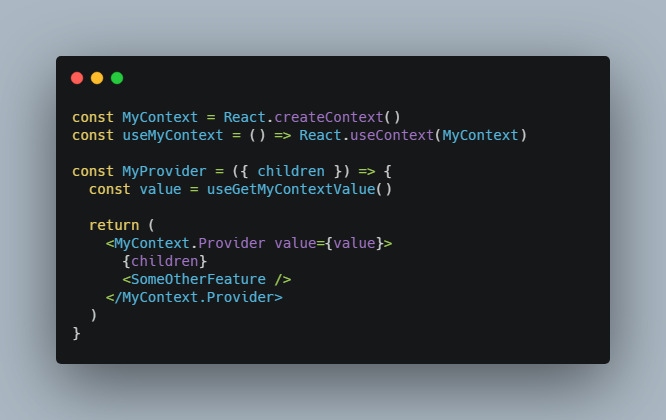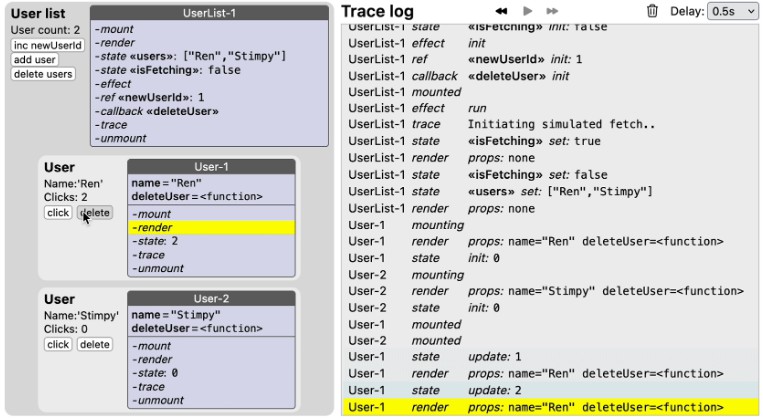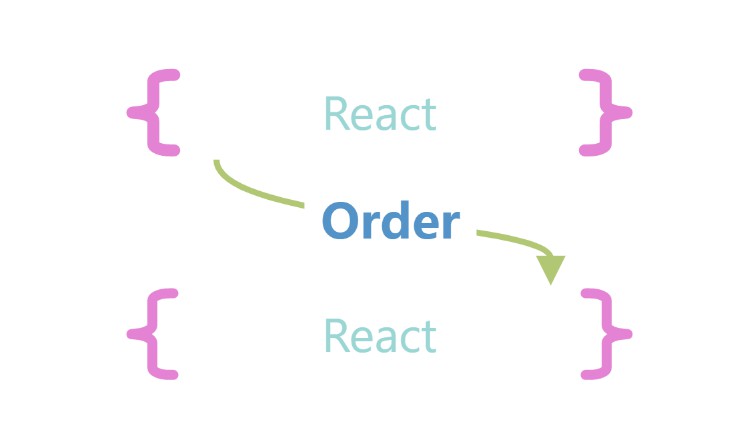react-generate-context
React Context with less boilerplate.
Creating a new React Context involves a few steps. react-generate-context removes a couple of those steps.
The react-generate-context package is a single function, generateContext, that generates a React Context (in closure) and returns to you the Provider and custom hook to access it in one step. All you need to do is give it a function the generate the value prop for your Context. Let’s go through an example:
import generateContext from 'react-generate-context'
/**
* `generateContext` receives a custom hook function that manages the `value`
* passed to the Provider under the hood. The function takes any `props` passed
* to the Provider
*/
const useGetCounterValue = ({ startingCount }) => {
const [state, setState] = React.useState(startingCount)
const handlers = React.useMemo(
() => ({
inc: () => {
setState(s => s + 1)
},
dec: () => {
setState(s => s - 1)
},
}),
[]
)
return [state, handlers]
}
/**
* generateContext returns a tuple of a Provider and a custom
* hook to consume the context. Array destructuring allows you
* to name the Provider and hook whatever you need to easily
*/
const [CounterProvider, useCounter] = generateContext(useGetCounterValue)
/**
* We can consume that context in a component with the hook
*/
function Counter() {
const [count, { inc, dec }] = useCounter()
return (
<div>
{count}
<div>
<button onClick={inc}>+</button>
<button onClick={dec}>-</button>
</div>
</div>
)
}
/**
* And use the generated Provider
*/
function App() {
return (
<CounterProvider startingCount={100}>
<Counter />
</CounterProvider>
)
}
Installation
npm install react-generate-context
or
yarn add react-generate-context
API
const [MyProvider, useMyContext] = generateContext(useGetContextValue, options)
generateContext receives two arguments: useGetContextValue and any options for your context.
useGetContextValue
type UseGetContextValue<Props, Context> = (props: Props) => Context
The useGetContextValue is a custom hook function that derives the value of your context. It is given any props passed to the Provider.
Example:
type Props = {
startingCount: number
}
type Context = [
number,
{
inc: () => void
dec: () => void
}
]
const useGetCounterValue = ({ startingCount }: Props): Context => {
const [state, setState] = React.useState(startingCount)
const handlers = React.useMemo(
() => ({
inc: () => {
setState(s => s + 1)
},
dec: () => {
setState(s => s - 1)
},
}),
[]
)
return [state, handlers]
}
options
options is an object for configuring settings for your context. The options are:
-
defaultContext– Avaluepassed toReact.createContext -
requireProvider– Set tofalseif its ok to use the returned hook without the Provider as a parent -
missingProviderMessage– A custom message to use as the error message for using the hook outside of the Provider
The defaults are:
const DEFAULT_OPTIONS = {
defaultContext: undefined,
requireProvider: true,
missingProviderMessage:
'The hook for this context cannot be used outside of its Provider',
}
Why?
Reducing boilerplate aside, there’s one other good reason to use a helper like generateContext when creating Contexts (or at least follow the pattern of its Provider).
The Provider returned to you does not allow you to put any components or elements in the same scope where the state change for the context is occurring. This prevents you from making a mistake that causes unnecessary rerendering. For example:
const MyContext = React.createContext()
const useMyContext = () => React.useContext(MyContext)
const MyProvider = ({ children }) => {
const value = useGetMyContextValue()
return (
<MyContext.Provider value={value}>
{children}
<SomeOtherFeature />
</MyContext.Provider>
)
}
In this instance, because we have composed SomeOtherFeature in the same scope as where our state change for value occurs, no matter what you do to SomeOtherFeature, even if it doesn’t consume useMyContext, it will be rerendered every time value changes.
The Provider returned to you by generateContext only allows you to use it with composition via children. It ensures that no mistake like the one above can be made now or in the future. Your Provider will work as well as it can. The onus is still on you to write a good custom hook to manage the value.





